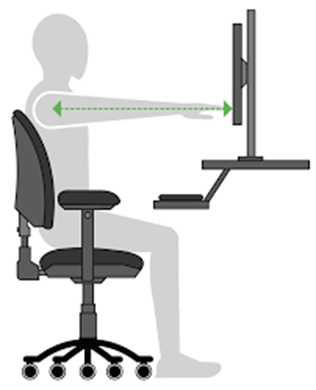If you’re someone who spends most of the week sitting in front of a computer for work there’s a good chance you’ve experienced some sort of neck, back or general office related pain. Since COVID, many of us have moved away from the office to our home-based setups which quite often aren’t set up appropriately. We’re going to share some tips that will help you set up your workstation for optimal comfort and minimize the risk of developing chronic pains and poor posture.

1. The chair
A good chair should provide a full backrest that supports the whole spine. The back rest should be slightly reclined between 10-20 degrees from vertical. You need to adjust the height of the chair to ensure that your knees are at a right angle and your feet should be well supported (preferably on the floor). Your bottom should be slid all the way back to the back rest and not near the edge of the seat causing you to slouch.

2. The desk
Your desk height should allow your elbows and forearms to be well supported without being too high and causing you to elevate your shoulders or flex your elbows more than 90 degrees (as displayed in the image). If the forearms are not supported this creates extra stress on your shoulders and the muscles of your neck. The keyboard, mouse and regularly used items should all be in close proximity to your body so that you are not overreaching frequently. Things that are used less frequently can be moved further away.

3. The monitor
The monitor should be placed straight in front of you so you are not spending long periods of time with your head turned. If you are using a double monitor you should have them fairly close to each other so you do not have to turn your head too far. Your eye level should be approximately one third of the way down from the top of the screen but no higher than the top of the monitor. Your monitor should be approximately arms distance away to prevent eye strain and headaches.

4. Posture
Be mindful of your head position. You want to try to keep the weight of your head directly centered above your shoulders and neck rather than leaning it forward to get closer to the screen. Positioning the head infront of the shoulders for prolonged periods creates extra stress on the neck muscles which can often lead to headaches and neck pain.
5. Taking Regular Breaks
Above all, the best way to reduce pain and fatigue during the work day is to take regular breaks from the screen. Try to schedule in a 1–2-minute stretch or walk every 30 mins- 1 hour. If you have the luxury of a sit to stand desk, utilise this with regular alternation. These breaks and the regular repositioning will increase your productivity throughout the course of the day!
If you would like further assistance with your workplace set up, come and visit one of our Osteopaths at Blackburn Allied Health Group. Our Osteopaths are trained in workplace ergonomics and can provide you with the tools and advice to achieve an optimal workplace set up.

